ASK 2023
Secondaries, debt attractive for portfolio stability: Korean CIOs
Faster returns and steady cash flow will keep portfolios robust; undervalued companies to shine during crisis, investment heads say
By May 17, 2023 (Gmt+09:00)
6
Min read
Most Read
LG Chem to sell water filter business to Glenwood PE for $692 million


KT&G eyes overseas M&A after rejecting activist fund's offer


Mirae Asset to be named Korea Post’s core real estate fund operator


StockX in merger talks with Naver’s online reseller Kream


Meritz backs half of ex-manager’s $210 mn hedge fund


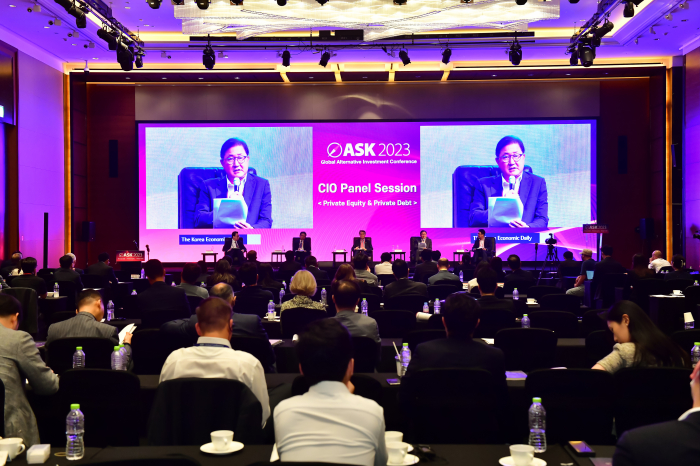
South Korean institutional investors find secondaries and private debt attractive amid the darkening economic outlook, chief investment officers (CIOs) said at the ASK 2023 conference, the biannual forum of alternative investments hosted by The Korea Economic Daily, held in Conrad Seoul on Wednesday.
As financial markets expect interest rates to remain high for the time being, investors are eyeing safe assets and stable income while managing credit and liquidity risks, said the asset management leaders from four institutions – Public Officials Benefit Association (POBA), Teachers’ Pension (TP), Military Mutual Aid Association (MMAA) and Hanwha Life Insurance Co.
The CIO panel session on private debt (PD) and private equity (PE) was moderated by Andrew Shin, head of investment services at Willis Towers Watson's Seoul office.
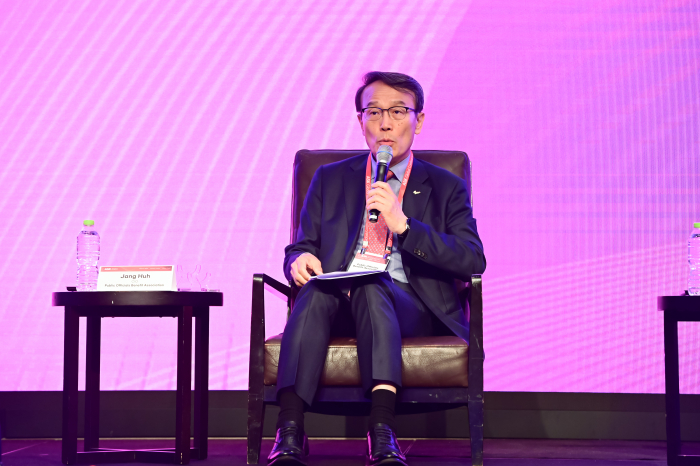
LIQUIDITY, CREDIT RISK TOP CONCERNS: POBA
Despite the US banking crisis and concerns over the commercial real estate crash, private assets are still more attractive than their traditional counterparts in terms of risk-return profile, POBA’s CIO Huh Jang said during the panel session.
Founded in 1975, the retirement fund for Korea’s provincial government employees is managing 22.5 trillion won ($16.9 billion) as of end-April. Alternative investments amount to 17 trillion won, where a combined PE and PD account for 38.9%. POBA aims for the mid-10% range and more than an 8% net internal rate of return (IRR) from PE and PD, respectively.
It will spur private credit investments this year with a particular focus on liquidity and credit risk management, Huh said.
"We are eyeing securitized assets and real estate investment trusts (REITs) that offer high liquidity, as well as investment-grade bonds with BBB or higher ratings for credit management. On real assets, we are looking at energy transition infrastructure and multifamily, rather than the office sector which suffers volatility today," the CIO said.
Korean mutual aid funds, including POBA and MMAA, had to increase the interest rates for their members' savings and payouts last year due to rate hikes. Although inflation-moderating moves and rate increases are near an end, POBA sees a deep recession is coming.
"We will take a very conservative approach to overall PE, but we are open to some special situations targeting financially challenged companies as PE funds with vintages during crises tend to perform well," he said.
POBA will exclude high-rated public bonds that offer low yield-to-maturity, and it is not considering global treasuries and investment-grade corporate bonds that require foreign exchange hedging costs, Huh added.
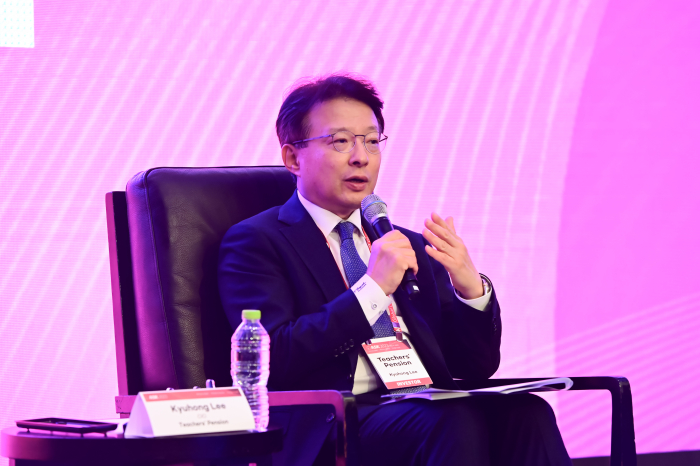
DEBTS WITH LOW LEVERAGE: TEACHERS’ PENSION
TP, a retirement fund for Korean private school employees, prioritizes accurate cash flow forecasts as its top value is stable returns over a long period, said CIO Lee Kyu-Hong during the session.
As mid-to-long-term strategies, the pension fund is seeking to increase overseas investments and raise exposure to alternative assets, which have low correlations with their traditional counterparts, Lee said.
Founded in 1974, TP is managing 23.2 trillion won under management as of end-April. Alternative investments amount to around 5.8 trillion won, where overseas assets make up 60%. Of the whole alternative investments, PE and PD make up 40% in aggregate.
“We believe that high interest rates could persist for a long period and the global economy will be further weakened. This will generate opportunities from secondary funds that provide quicker returns and from distressed and special situation strategies targeting undervalued companies,” the CIO said.
“When selecting blind pool funds, we focus on two major issues – low leverage and mitigation of downside risk. The latter is particularly important for TP to pick debt funds that contain strict covenants to protect limited partners,” Lee added.
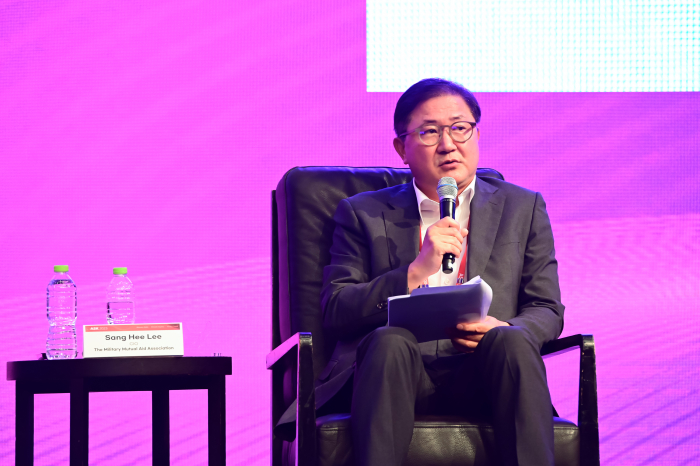
SECONDARIES, DISTRESSED FUNDS WILL SHINE: MMAA
MMAA, a retirement savings fund for Korean military personnel, is taking a very conservative stance on the private market given growing uncertainties. The fund initially allocated 600 billion won for a combined PE and PD this year, but slashed the money to 390 billion won amid concerns of a liquidity crisis.
Established in 1984, the pension fund is managing 10.1 trillion won in assets as of end-April. Alternative investments amount to around 7.8 trillion won, where local and overseas PE and PD make up around 39.8%. It targets 6.57% of the average return from the two asset classes.
It will raise exposure to secondaries for faster exits and also look for opportunities from undervalued company stakes, distressed assets and special situation strategies, CIO Lee Sang-hee said. Lee, who formerly led fund management at Lotte Insurance Co., started a three-year term at MMAA in May 2021.
“The military fund forecasts high interest rates will continue for a while, raising credit and liquidity risks of corporates. We will be very careful with venture capital investment this year in expectations of a liquidity shortage,” he said.
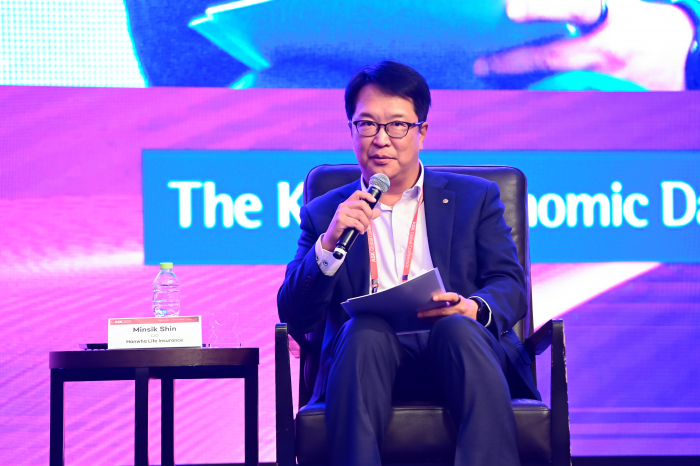
PROFITABILITY CHALLENGED UNDER NEW RULE: HANWHA LIFE
Hanwha Life Insurance Co. has bulked up investing in PD since last year as lowered loan-to-value and rate hikes benefit lenders, CIO Shin Min-sik said during the session.
The major insurance arm of Hanwha Group, a power plant-to-defense conglomerate, is managing 86.4 trillion won as of end-March. Alternative investments reach 23 trillion won, where local and overseas PE and PD account for 3.9%. It targets a 15% return from the two asset classes.
Hanwha Life will accelerate investments in secondaries this year as many LPs are expected to sell their high-quality PE at a significant discount to secure liquidity. The insurer will increase exposure to secondaries in the US and Western Europe to mitigate foreign exchange risks while seeking to expand investments in Asia in the long term, Shin said.
The insurer will manage the existing portfolio of PE as the public market’s tumble last year will increasingly affect private markets. It will also be more careful with mezzanine financing, the tranche between senior debt and equity, as it is riskier in terms of investment recovery in the economic downturn, the CIO said.
The insurer has allocated 750 billion won at PD and PE investments for 2023. It is taking a prudent approach to PE investments this year given longer-than-expected fluctuations in valuations. In mid-to-long term, it will gradually expand exposure to PE via secondary and distressed funds, Shin added.
"Korean insurers are struggling to secure both profitability and financial stability under International Financial Reporting Standard (IFRS) 17, the stricter accounting standard that the local insurance industry started applying this year. With the tightened regulations, insurers will strive even more for balanced investment portfolios," he said.
Write to Jihyun Kim at snowy@hankyung.com
Jennifer Nicholson-Breen edited this article.
More to Read
-
 ASK 2023Alternative investment forum ASK 2023 to kick off May 17 in Seoul
ASK 2023Alternative investment forum ASK 2023 to kick off May 17 in SeoulMay 04, 2023 (Gmt+09:00)
3 Min read -
 ASK 2023Private debt will offer both income and downside protection: ASK 2023
ASK 2023Private debt will offer both income and downside protection: ASK 2023May 17, 2023 (Gmt+09:00)
3 Min read -
 InsuranceHanwha Life acquires majority stake in Indonesian Insurer Lippo
InsuranceHanwha Life acquires majority stake in Indonesian Insurer LippoMar 30, 2023 (Gmt+09:00)
1 Min read -
 ASK 2022Teachers' Pension continues focus on global residential, logistics
ASK 2022Teachers' Pension continues focus on global residential, logisticsOct 26, 2022 (Gmt+09:00)
2 Min read -
 Pension fundsMilitary fund to raise payouts with interest rate increases
Pension fundsMilitary fund to raise payouts with interest rate increasesJun 28, 2022 (Gmt+09:00)
2 Min read -
 ASK 2022POBA targets upper-middle market in North America for PD investment
ASK 2022POBA targets upper-middle market in North America for PD investmentMay 23, 2022 (Gmt+09:00)
2 Min read
Comment 0
LOG IN


